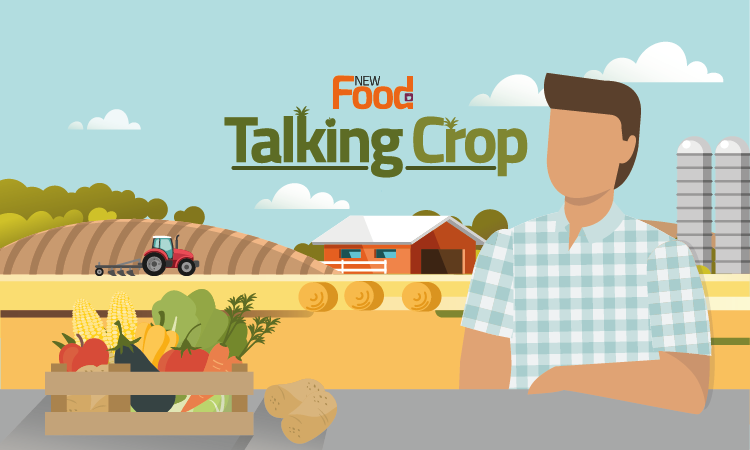Plant hormones and crop quality
- Like
- Digg
- Del
- Tumblr
- VKontakte
- Buffer
- Love This
- Odnoklassniki
- Meneame
- Blogger
- Amazon
- Yahoo Mail
- Gmail
- AOL
- Newsvine
- HackerNews
- Evernote
- MySpace
- Mail.ru
- Viadeo
- Line
- Comments
- Yummly
- SMS
- Viber
- Telegram
- Subscribe
- Skype
- Facebook Messenger
- Kakao
- LiveJournal
- Yammer
- Edgar
- Fintel
- Mix
- Instapaper
- Copy Link
Posted: 23 July 2020 | Gideon Ashworth | No comments yet
Gideon Ashworth’s latest ‘Talking Crop’ discusses the effect of plant health and hormones on food quality, and the impact climate change is having on the agri-food market.


Delivering quality food is what we are – or at least should be – aiming for in our various professional roles, with quality being defined as ‘meeting or exceeding customer expectation’. The modern food industry has been developed on the principle foundations of safe, quality food; this month I’d like to bring hormones to the forefront, highlighting the effects on food quality.
Crop quality is a combination of growing conditions and how farmers control the multiple variables, including soil type, altitude, local weather and climate. Some regions of the world are particularly challenging areas to raise crops, and it comes as no surprise that COVID-19 is catalysing the concerns surrounding food security now and potentially well into the future.
A changing climate does little to ease agri-food challenges, nearly all farmers around the world I have spoken with over the past few years are directly affected in some way, whether soil degradation, water scarcity (or flash flooding), altered sunlight intensity caused by increased humidity or elevated wind speeds. Things are changing fast; we must understand the fundamentals about how our crops adapt to their environments so that we can best maintain the quality (and safety) of our food.
Agriculture has evolved over millennia, striving for efficiencies, increased yields and quality parameters. These factors can be compromised when we consider the pressure on land to satisfy an increasing demand. We have a growing global human population, with ever increasing affluence and therefore, more freedoms of purchase choice. These pressures on the land and crop quality should be at the forefront of our minds as we evolve our tiny segment of agricultural history for the future.
Plant hormones are seldom considered when discussing crop quality, however they play an essential role in plant health.
There are a number of plant hormones, but in this column, I will touch on the five main types, offering a simplified overview of hormone function. If you are a person who enjoys learning about the innermost workings of plant life (like myself) I will indulge you with an exam revision mind map of plant hormones from the annals of my horticultural education; the simple anagram ‘a cage’:
|
Hormone |
Function |
|
|
Auxin |
Promote plant growth (roots, stems flowering, fruit set) |
Promote production of other hormones |
|
Cytokinin |
Cell division |
Produced in the roots |
|
Abscisic acid (ABA) |
Growth inhibitor |
Stomatal closure and promotes leaf senescence |
|
Gibberellins |
Promote plant growth |
Generated in new growth |
|
Ethylene |
Promotes fruit ripening |
Crucial postharvest hormone |
Hormones are present at extremely low levels. Ethylene is a hormone that you may be familiar with and is the culprit that encourages over-ripening of your bananas, or that seemingly impossible prospect of ‘ripen at home’ fruit, which, for some households, are rock solid inedible peaches one day then an intolerable soft puree the next. Fruit can be classified into two main types, climacteric, which produce and absorb the ripening hormone ethylene, and non-climacteric, which do not produce, nor are sensitive to the effects of ethylene. There is also an in-between category, ‘ethylene sensitive’ which can be affected by ethylene, but do not produce it.
A climacteric fruit produces ethylene as well as ethylene receptors on its skin (demonstrating that ripening is an exponential curve). Ethylene control comprises removal in transport and storage and deliberate addition (‘triggering’ in ripening chambers). It is an essential component of quality for many of our crops – a simple and visible demonstration of how plant hormones effect quality and our control and influence over it. By controlling ethylene (as well as temperature and gas concentrations) we have developed the capabilities to transport fruit globally, offering us choice and a varied diet in an otherwise seasonally affected area.
Believe it or not, like us, plants experience positive and negative stress. With the increasing challenges of climate change and industrialisation, crops are being exposed more and more to varied intensities of stress. However, plant stress is dictated by the immediate environmental conditions, ie, sunlight, temperature, nutrient availability, pests and diseases, physical injury, exposure to toxins and crucially, water.
Crops require water for photosynthesis, so the balance of water and sunlight, (with sufficient nutrients) is key to their health. If water availability reduces, the stomata (located on the underside of the leaves) close (become flaccid). This mechanism is triggered by the production of abscisic acid, resulting in less water loss via transpiration. Less transpiration equals less photosynthesis, which is not what we need for optimum quality, hence, the requirement for the right balance of all growing parameters.
The multiple singular plants that make the whole crop are busy at work, ensuring they grow to the best of their abilities in their given surroundings. As we progress with the development of crop production, complemented by postharvest storage and transport, plant hormones play a crucial role in ensuring plant health and the quality we, and our customers, strive for.
Related topics
Environment, Ingredients, Quality analysis & quality control (QA/QC), Supply chain, Sustainability









